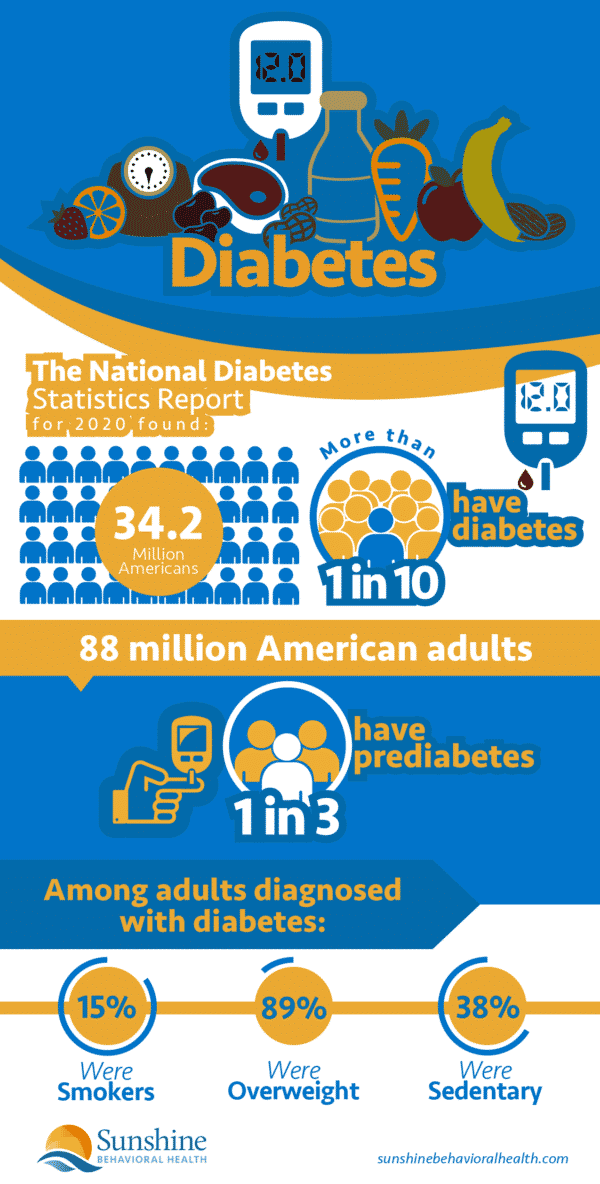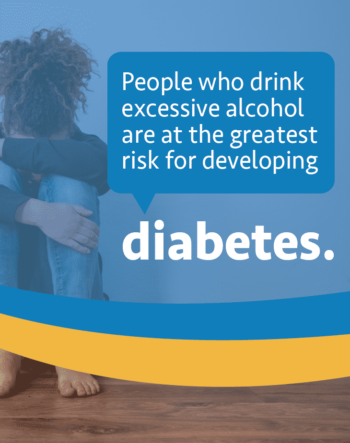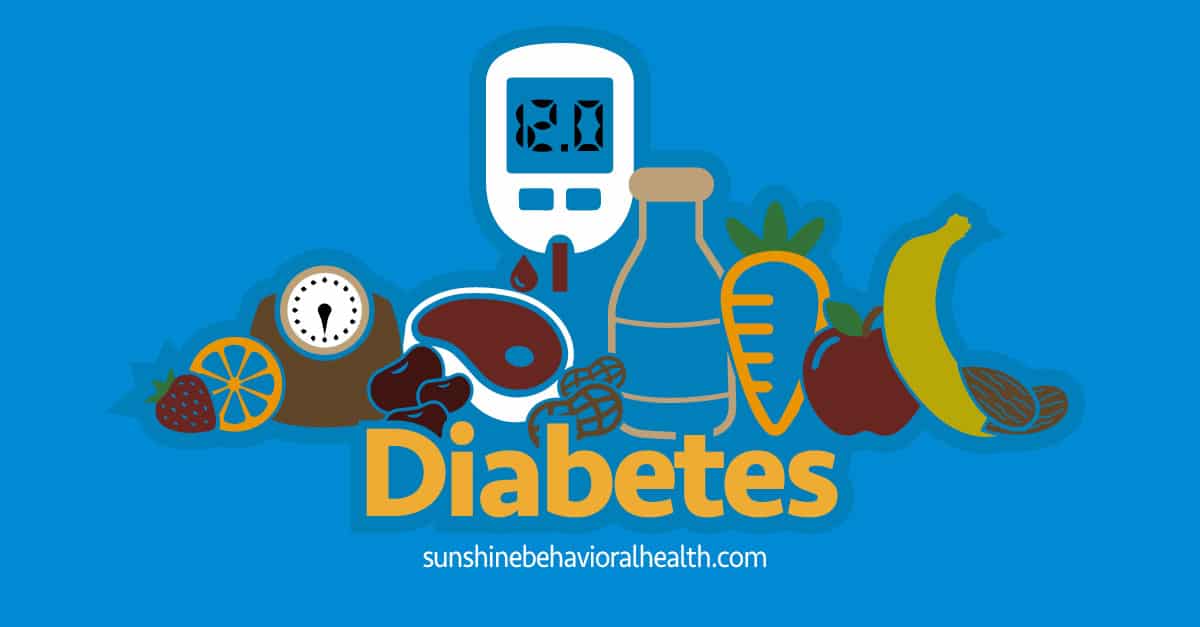While there’s no cure for diabetes, it’s a manageable disease for many people. Diet, exercise, and prescription medication help keep the condition under control. However, for people struggling with substance use disorder, diabetes can pose significant health risks.
What is Diabetes?
Also called diabetes mellitus, diabetes occurs when the body’s blood glucose (or blood sugar) is too high. The human body uses blood glucose for all its energy. A hormone called insulin helps move glucose from the food that’s consumed to the body’s cells. However, if the body doesn’t make an adequate supply of insulin or doesn’t use the insulin well, the glucose stays in the bloodstream instead of reaching the cells. Health problems can occur when there’s consistently too much glucose in the bloodstream.
Diabetes is a chronic condition, meaning it doesn’t go away. Along with insulin, care plans usually involve lifestyle modifications, including physical exercise and diet.
Types of Diabetes
About 34 million people in the United States have some form of diabetes. Another 88 million have pre-diabetes, a condition that occurs when someone has higher than normal glucose levels but not high enough to be diagnosed with diabetes.
Type 1 Diabetes
Usually diagnosed in childhood or young adulthood, Type 1 diabetes (once referred to as juvenile diabetes) occurs when the body simply does not make enough insulin. In some cases, it doesn’t produce any insulin at all. The immune system targets the insulin-making cells in the pancreas. To stay alive, people with this type of diabetes must take insulin every day either as an injection or via an insulin pump.
Type 2 Diabetes
Type 2 diabetes is the most common type of diabetes. It occurs when the body does not make enough insulin or does not use the insulin it makes appropriately. This type can be diagnosed at any point, including childhood. It used to be more commonly referred to as adult-onset diabetes, because it tends to be diagnosed more among older adults, but higher obesity rates among children led to more youths developing Type 2.
Other Types of Diabetes
Women sometimes develop a condition called gestational diabetes during pregnancy. While this type usually goes away after the baby is born, the woman is at greater risk of developing Type 2 diabetes later in life. The exact cause is unclear, but being overweight before pregnancy may be a factor. Other risk factors include:
- A sedentary lifestyle
- A previous case of gestational diabetes
- A prediabetes diagnosis
- An immediate family member with diabetes
- Previously giving birth to a baby that weighed more than 9 pounds
- Polycystic ovary syndrome
Women who are Black, Hispanic, or American Indian, or Asian American are at greater risk of developing gestational diabetes, too.
Other types of diabetes include monogenic diabetes and cystic fibrosis-related diabetes.

Diabetes and Substance Use Disorder
People with diabetes who struggle with addiction to drugs or alcohol are at serious risk of health complications. Unfortunately, studies have found people with diabetes have higher rates of substance use disorder than people without diabetes. A 2012 Internal Medicine Journal study found that of some 500 people with Type 1 diabetes, 77% had used recreational drugs and 47% had used drugs within the last year. Among those who used drugs, about a quarter said they used drugs daily. This may be due to the fact that people with diabetes sometimes use opioids to manage neuropathic pain caused by diabetes.
Studies show around two-thirds of people with Type 1 and Type 2 diabetes have diabetic neuropathy; of all diabetics, 20% have chronic neuropathy pain. Opioids are not a first-line medication to treat the pain associated with diabetic neuropathy. Doctors generally prescribe antidepressants, anticonvulsants, and anti-inflammatory drugs first. Even so, about 40% of people with diabetic neuropathy take opioids to manage the pain.
Regardless, drug and alcohol abuse is quite dangerous for people with diabetes. This is largely because these substances affect how the body metabolizes glucose. In simpler terms, drugs, and alcohol cause glucose to be too low or too high, both of which are dangerous for people with diabetes.
When glucose is too high, it’s called hyperglycemia; when it’s too low, it’s hypoglycemia. These conditions can result in complications like:
- Organ damage, specifically to the kidneys
- Nerve damage that leads to skin ulcers, paralysis, and ultimately limb amputations
- Blood vessel damage, causing heart attacks, stroke, and hardening of the arteries
- Coma due to a blood sugar imbalance
Additionally, when insulin is too low, the body uses stored fat as an energy source. This prompts the production of ketones, a byproduct of the breakdown of fatty acids. When insulin and other hormones are normal, the body can balance ketones. When insulin isn’t normal, the body can’t regulate ketones, which causes them to build up in the blood, leading to diabetic ketoacidosis, especially among those with Type 1 diabetes.
Symptoms of diabetic ketoacidosis include:
- Significant thirst
- High blood sugar and ketones in the urine
- Nausea or vomiting
- Abdominal pain
- Frequent urination
- Confusion and fatigue
- Fruity-smelling breath
- Flushed skin
People with ketoacidosis must seek medical attention immediately. Left untreated, diabetic ketoacidosis can lead to a coma or death.
There’s a more practical reason substance use disorder is dangerous for people with diabetes. Diabetes must be treated proactively. People with diabetes must be intentional about what they eat, when they eat, and how they eat. They must get plenty of physical activity. Perhaps most important, they must consistently monitor their blood glucose levels to avoid complications.
However, people with addiction to drugs or alcohol may not be as mindful of their health. They may not:
- Eat properly
- Follow up with doctors
- Have lab work performed
- Exercise regularly
Diabetes and Alcohol
People who are diagnosed with diabetes must take care not to overindulge in alcohol. Women with diabetes are advised to have no more than one drink per day while men can have two. However, there is a caveat. If a person with diabetes already experiences high blood pressure, nerve damage, or problems with their eyes, doctors say they should not consume alcohol at all.
That’s because alcohol consumption negatively affects glucose levels in the body. It inhibits both insulin and glucagon, the hormones that keep blood glucose from becoming too high or too low, respectively.
Even in moderation, drinking causes excessively high glucose levels or hyperglycemia, sometimes called alcohol-induced hyperglycemia. That’s because alcoholic beverages such as beer and wine as well as many mixers contain high amounts of carbohydrates. When a beverage is consumed, the carbs it contains are broken down very quickly into glucose. This makes the body’s blood glucose levels rapidly increase.
Alcohol-Induced Hyperglycemia
In chronic drinkers, the body often remains in a state of hyperglycemia. Compounding the problem, chronic alcohol consumption decreases the body’s responsiveness to insulin, the hormone that reduces the amount of sugar in the blood. That’s why chronic consumption of high-carb beverages combined with an overall lower insulin response creates a very dangerous situation for people with diabetes.
Alcohol-Induced Hypoglycemia
 On the other end of the spectrum, drinking alcohol slows down the liver, the organ where glucose is stored as glycogen. When the liver doesn’t respond as it should, adequate glucose isn’t released into the bloodstream as quickly. This causes hypoglycemia or low blood sugar.
On the other end of the spectrum, drinking alcohol slows down the liver, the organ where glucose is stored as glycogen. When the liver doesn’t respond as it should, adequate glucose isn’t released into the bloodstream as quickly. This causes hypoglycemia or low blood sugar.
Hypoglycemia may not occur immediately after alcohol consumption. It can take up to 24 hours for someone to experience alcohol-induced hypoglycemia. The reason for this is two-fold.
First, liver function slows down significantly after drinking alcohol, which means glucose isn’t entering the bloodstream in high enough amounts to meet the body’s energy needs. Second, hypoglycemia often mimics intoxication. A chronic drinker with diabetes may never realize he or she is experiencing hypoglycemia and take steps to correct the problem. If hypoglycemia is not remedied, it can lead to diabetic ketoacidosis and other serious health problems.
Other Consequences of Diabetes and Alcohol
Alcohol can make nerve damage worse in people with diabetes. Diabetic nerve damage increases sensitivity to touch while decreasing motor function. It is painful as well as debilitating. Some diabetics who abuse alcohol experience hyperalgesia, a condition where damaged nerves become even more painful due to excessive alcohol consumption.
Loss of vision can also occur when diabetics abuse alcohol. Alcohol slows brain activity, which in turn causes the pupils to react slower. As time progresses, eye muscles will become weaker, causing permanently blurred or double vision.
Excessive alcohol intake also makes insulin medications less effective, and it can make some people eat more than usual. This is a dangerous combination. Insulin regulates glucose, but if alcohol prevents it from working and the person is eating more, it only makes sense that a blood sugar imbalance such as hyperglycemia would occur.
Drugs and Diabetes
Just like alcohol, drug use is extremely dangerous for people with diabetes. Drugs make it difficult to maintain glycemic control. Because drugs affect the way the brain normally functions, people with diabetes often neglect to take their medications as scheduled and may underreport their glucose levels. They may also avoid eating the right kinds of foods on a consistent schedule. This can lead to extremely low blood sugar and ketoacidosis in people with Type 1 diabetes.
Symptoms of ketoacidosis include:
- Abdominal pain
- Vomiting
- Dehydration
- Sweet-smelling breath
Those with Type 2 diabetes often have the opposite problem. If they neglect to take medication that regulates their glucose level, they can develop hyperglycemia, which causes high blood sugar levels.
Research also indicates diabetics who use drugs end up in the hospital more often than those who do not. A study conducted at a Spanish hospital found that 20% of adult diabetes patients tested positive for drugs — mostly marijuana and cocaine. Seventy percent of those patients who tested positive for drug use were admitted to the hospital more than once.
Cocaine and Diabetes
Cocaine, a highly addictive stimulant drug, poses several significant risks to people with diabetes. First, cocaine makes blood vessels constrict, causing blood pressure to increase. When this happens, the risk of heart attack and stroke also increases. Since people with diabetes are already at greater risk for these issues, using an illicit drug like cocaine increases their likelihood of a cardiovascular event even more.
Cocaine also suppresses the appetite. Research has found that regular cocaine users eat fewer balanced meals than those who don’t use cocaine. Cocaine users eat more fatty foods, too. Following an irregular eating pattern is dangerous for those with diabetes. Forgoing food will ultimately cause dangerously low blood glucose levels, and choosing unhealthy food can prevent insulin or other prescription medication from working properly.
Cocaine also causes the body to break down carbohydrates more quickly. This can cause low blood sugar, which can be remedied by eating a piece of candy or drinking a glass of juice. However, the person’s mental state may prevent him or her from being able to recognize the symptoms of hypoglycemia.
Methamphetamine and Diabetes
Methamphetamines cause the release of too much sugar into the bloodstream, thus leading to hyperglycemia. The drug interferes with insulin activity and hormone production and can also decrease appetite. Memory loss may also occur, which is dangerous for diabetics who must take medication and monitor their blood sugar levels regularly.
Heroin and Diabetes
Heroin is a depressant drug that can affect healthy eating patterns and prevent the body’s hormones from working properly. The drug can make it difficult for a person with diabetes to maintain safe glucose levels, even if he or she is taking insulin or other prescription drugs. Like all opioids, heroin increases the concentration of hormones like glucagon, which will cause an increase in blood glucose.
Additionally, diabetics are already at risk for vascular issues, ulcers, and organ damage. Using heroin is extremely hard on the body’s systems, including the veins, liver, and kidneys. Therefore people with diabetes who use heroin are causing further damage to their bodies.
Can Substance Use Disorder Cause Diabetes?
Yes, it can. People with a substance use disorder disorder who don’t have diabetes may be more prone to develop it, specifically Type 2 diabetes. People who drink excessive alcohol are at the greatest risk for developing diabetes. Drinking too much alcohol will damage the pancreas, which will prevent it from secreting insulin, thus leading to diabetes.
Other illicit and recreational drugs may play a role in a person developing Type 2 diabetes. Specifically, drugs can:
- Cause cell damage
- Decrease antioxidant potential of cells
- Impact glucose metabolism
- Lead to poor diet choices
Addiction Treatment for People With Diabetes
Alcohol consumption is more prevalent in adults with Type 2 diabetes, but illicit drug abuse is common among people with both primary types of diabetes. Substance use disorder causes severe damage to most major organs in the body, including the heart and kidneys. Since people with diabetes are already at significant risk of organ damage and cardiovascular disease, addiction to drugs or alcohol increases their chance of medical complications and death.
Diabetics who stop drinking alcohol or taking drugs can experience painful withdrawal symptoms. These symptoms might include body pain, sweating, fever, vomiting, and nausea, diarrhea, and cravings. These symptoms make it even more difficult for a person with diabetes to control his or her blood sugar.
There’s no easy answer for addiction, and chronic health conditions like diabetes complicate it further. However, a person with diabetes needs to get help for their substance use disorder disorder to reduce the risk of serious health complications or death. While it’s best to avoid drugs altogether and keep alcohol consumption to a minimum, seek professional treatment at the first sign of addiction. Trained professionals can help diabetics manage both conditions so they can live a healthier life.
Sources
Medical disclaimer:
Sunshine Behavioral Health strives to help people who are facing substance abuse, addiction, mental health disorders, or a combination of these conditions. It does this by providing compassionate care and evidence-based content that addresses health, treatment, and recovery.
Licensed medical professionals review material we publish on our site. The material is not a substitute for qualified medical diagnoses, treatment, or advice. It should not be used to replace the suggestions of your personal physician or other health care professionals.







